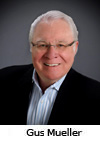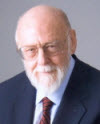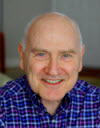 While the focus of this month's 20Q was the 50th anniversary of the pioneering research in the area of auditory processing by Doreen Kimura, we easily could have had a similar article regarding the work of James Jerger. In fact, it was 51 years ago when he published the now-classic article: Observations on Auditory Behavior in Lesions of the Central Auditory Pathways. At that time he already was using several different speech tests to assess higher auditory function. A few years later we saw the birth of the Synthetic Sentence Identification (SSI) test, which led to the Dichotic Sentence Identification (DSI). Dr. Jerger's publications and insights over the years have charted the course for the clinical evaluation of auditory processing.
While the focus of this month's 20Q was the 50th anniversary of the pioneering research in the area of auditory processing by Doreen Kimura, we easily could have had a similar article regarding the work of James Jerger. In fact, it was 51 years ago when he published the now-classic article: Observations on Auditory Behavior in Lesions of the Central Auditory Pathways. At that time he already was using several different speech tests to assess higher auditory function. A few years later we saw the birth of the Synthetic Sentence Identification (SSI) test, which led to the Dichotic Sentence Identification (DSI). Dr. Jerger's publications and insights over the years have charted the course for the clinical evaluation of auditory processing.Another audiologist involved with the study of brain function in the early 1960s was Jack Katz. As most of you already know, Jack developed the Staggered Spondaic Word (SSW) test, which over the past several decades has been the most popular speech material for assessing auditory processing. The SSW turns 50 next year, as it was first introduced in a 1962 article in the Journal of Auditory Research. Generations of audiologists have become involved with the use of the SSW and the assessment of auditory processing because of the contagious enthusiasm of Dr. Katz.
Over the past 30 years, one of the strongest advocates for the audiologic assessment of brain function has been Frank Musiek. Like Drs. Jerger and Katz, he too has developed specific auditory tests for the study of central auditory processing. Probably the most well known is his dichotic digit test, similar to that of Kimura's, which has been used internationally in the study of auditory processing disorders and brain function.
We're fortunate to have these three audiology legends join us here at 20Q. I'm sure you'll enjoy reading their comments regarding the work of Dr. Kimura as much as I did.
Gus Mueller
Contributing Editor
August 2011
From James Jerger
 This 20Q article brings back a host of memories. In the winter of 1959 I spent a fruitful week in Montreal visiting colleague and good friend, Earl Harford. Earl had just accepted a faculty position at McGill University and a supervisory position as chief audiologist at the Royal Victoria Hospital. During that week Earl and I visited the nearby Montreal Neurological Institute (MNI) where we had the good fortune to meet Herbert Jasper, originator of the 10-20 electrode system of the International Federation, and to observe the great neurosurgeon, Wilder Penfield, operate on a patient with epilepsy. But even more interesting for me was a visit to the laboratory of Brenda Milner at MNI. Here I met Brenda, and perhaps Doreen as well, although I do not remember doing so. I was shown the now famous "modest" stereo tape recorder on which they had recorded, somewhat laboriously, a set of dichotic digits in the manner of Donald Broadbent. This was two years before the publication of the now famous 1961 paper by Doreen in the Canadian Journal of Psychology.
This 20Q article brings back a host of memories. In the winter of 1959 I spent a fruitful week in Montreal visiting colleague and good friend, Earl Harford. Earl had just accepted a faculty position at McGill University and a supervisory position as chief audiologist at the Royal Victoria Hospital. During that week Earl and I visited the nearby Montreal Neurological Institute (MNI) where we had the good fortune to meet Herbert Jasper, originator of the 10-20 electrode system of the International Federation, and to observe the great neurosurgeon, Wilder Penfield, operate on a patient with epilepsy. But even more interesting for me was a visit to the laboratory of Brenda Milner at MNI. Here I met Brenda, and perhaps Doreen as well, although I do not remember doing so. I was shown the now famous "modest" stereo tape recorder on which they had recorded, somewhat laboriously, a set of dichotic digits in the manner of Donald Broadbent. This was two years before the publication of the now famous 1961 paper by Doreen in the Canadian Journal of Psychology.In this era of super technology, in which instrumentation grows ever more complex, it is refreshing to remind ourselves that many important breakthroughs were achieved by well-trained and clever people using what must be described by today's standards as exceedingly primitive equipment. The discovery of the right-ear advantage in dichotic listening was one such breakthrough. A better tape recorder would have been fine, but the really crucial ingredient was that the MNI investigators, Milner & Kimura, were trained to ask the right questions and gather and appreciate the right evidence. Their basic knowledge of the neuroanatomy and neurophysiology of the central auditory pathways, coupled with their understanding of how language processing is asymmetrically represented in the brain, permitted them to make sense of what might have seemed, to less well-trained individuals, an unexplained anomaly in the data.
It is noteworthy that after 50 years of research on the REA, Doreen's original structural hypothesis has retained much of its explanatory strength. In the intervening years we have learned a good deal about attentional and other cognitive influences on dichotic listening, but Doreen's structural explanation, based on crossed pathways, the suppression of ipsilateral by contralateral pathways, and the representation of linguistic processing in the left hemisphere in most individuals, remains an essential ingredient for understanding this basic asymmetry in sensory and perceptual processing.
I congratulate Dr. Kimura anew on her unique accomplishment, and I congratulate Gus Mueller on putting together this remarkable article.
From Jack Katz
 What a fascinating 20Q article by Doreen Kimura. I am amazed by the breadth of her work and her general discussion of brain asymmetries. Much of these contributions are often taken for granted as people do not know where these powerful concepts came from.
What a fascinating 20Q article by Doreen Kimura. I am amazed by the breadth of her work and her general discussion of brain asymmetries. Much of these contributions are often taken for granted as people do not know where these powerful concepts came from.I was working on the SSW test at the same time that Dr. Kimura was developing her adaption of Broadbent's test. I was a little more fortunate in recording the first SSW test as I found a reel-to-reel tape recorder (Korting) that permitted us to record on each channel separately. We recorded the second channel based on the first word in the first channel so that it would coincide with the second word. But it was trial and error. To make sure that the competing words were 'perceptually centered' we then listened to both channels at the same time and rerecorded the second channel as needed.
To this day I continue to explain dichotic listening effects based on the anatomical diagram that Kimura provided in 1961. This and the explanation for the right-ear-advantage have played an important role in my understanding of the dichotic process. In fact, just recently I became aware of another asymmetrical auditory phenomenon that I had never noticed before. So even after 50 years, Dr. Kimura's work continues to impact my thinking.
From Frank Musiek
 Doreen Kimura is one of the most famous and respected neuropsychologists of the past half century. Unfortunately, many audiologists do not know of her many outstanding contributions, partly because most of her research has been published in psychology and neuroscience journals. Without question, her work has had a profound influence on our knowledge of central auditory function and dysfunction.
Doreen Kimura is one of the most famous and respected neuropsychologists of the past half century. Unfortunately, many audiologists do not know of her many outstanding contributions, partly because most of her research has been published in psychology and neuroscience journals. Without question, her work has had a profound influence on our knowledge of central auditory function and dysfunction. As Gus mentioned in his introduction to this 20Q article, she published two classic papers in 1961, both on dichotic listening. Dr. Kimura was perhaps the first to show the marked effect of temporal lobe lesions on dichotic listening. As she discussed in this 20Q article, she employed a carefully designed approach and demonstrated the contralateral ear effect for patients with temporal lobe compromise using her dichotic digit listening task. Moreover, in 1961 she formulated a now well accepted theory on the brain mechanisms underlying dichotic listening. Key to this hypothesis was the suppression of ipsilateral pathways in dichotic listening. This was a concept that our lab was able to quantify by the investigation of dichotic interaural intensity differences in split brain patients many years later. Dr. Kimura also made historic contributions to the hemispheric specialization of music and more recently on gender differences in cognition.
Early in my career I read about Kimura's work and it motivated me to study her dichotic listening tasks. She used three digits presented to each ear. I believed this was too much of a memory strain and I felt compelled to develop a more clinically friendly dichotic procedure. Henceforth, our dichotic digit test using only two digits to each ear evolved, which we introduced in the early 1980s.
I first met Dr. Kimura at a symposium in Canada around the time we were developing our test. I recall that people talked about her work with great admiration and respect then as they do today. I personally believe Dr. Kimura has not only profoundly impacted our understanding of dichotic listening but also the understanding of neural mechanisms in healthy and brains with various disorders. She truly is a giant in auditory as well as other sensory brain processes.
Read Dr. Kimura's 20Q article here.


